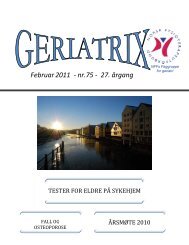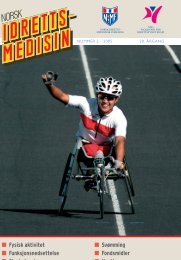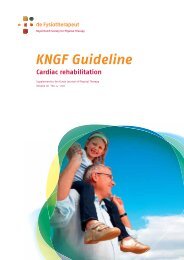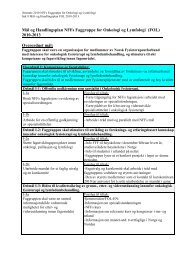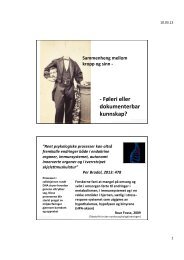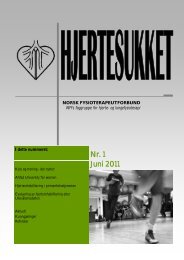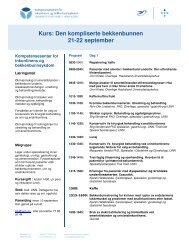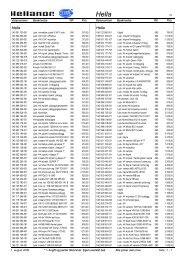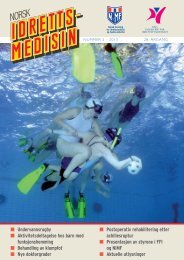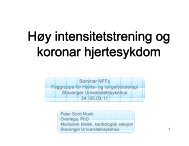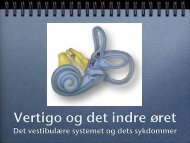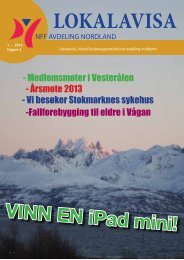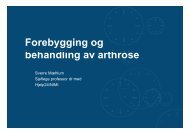Sustained Elevation of Circulating Growth and Differentiation Factor ...
Sustained Elevation of Circulating Growth and Differentiation Factor ...
Sustained Elevation of Circulating Growth and Differentiation Factor ...
You also want an ePaper? Increase the reach of your titles
YUMPU automatically turns print PDFs into web optimized ePapers that Google loves.
Clinical InvestigationsAcute muscle loss in critically ill patients causes weaknessranging from mild loss <strong>of</strong> strength <strong>and</strong> musclewasting to pr<strong>of</strong>ound muscle weakness. Severe weaknessin this context is known as ICU-acquired paresis (ICUAP),which is associated with significant mortality <strong>and</strong> morbidity(1). Although it is a common problem, affecting at least 25% <strong>of</strong>patients admitted to critical care (2, 3), our underst<strong>and</strong>ing <strong>of</strong>the underlying pathological mechanisms is limited. Sepsis, systemicinflammatory response syndrome, immobility, <strong>and</strong> hyperglycemiaare all thought to be major etiological risk factorsfor the development <strong>of</strong> ICUAP (1, 4–7). However, elucidation<strong>of</strong> the molecular mechanisms involved in human cases is difficult,<strong>and</strong> evidence has <strong>of</strong>ten been contradictory. In part, thisis because data are <strong>of</strong>ten obtained on ICU from heterogenousgroups <strong>of</strong> patients with ICUAP with a range <strong>of</strong> reasons for ICUadmission <strong>and</strong> varying lengths <strong>of</strong> stay.As in other disease processes, muscle mass in critically ill patientsis determined by the balance between dynamic processesmediating muscle breakdown (atrophy, apoptosis, <strong>and</strong> autophagy)<strong>and</strong> synthesis (protein synthesis <strong>and</strong> satellite cell recruitment).Myostatin, a member <strong>of</strong> the transforming growth factorβ(TGF-β) superfamily, is a well-recognized negative regulator<strong>of</strong> muscle mass (8), which has been implicated in the development<strong>of</strong> ICUAP. <strong>Elevation</strong> <strong>of</strong> both myostatin messenger RNA(mRNA) <strong>and</strong> protein was observed in the muscle <strong>of</strong> critically illpatients (9) <strong>and</strong> increased circulating levels <strong>of</strong> myostatin wereobserved in patients with muscle wasting associated with chronicobstructive pulmonary disease (10), cardiac failure (11), <strong>and</strong>liver failure (12). Other members <strong>of</strong> the TGF-β family also regulatemuscle phenotype. <strong>Growth</strong> <strong>and</strong> differentiation factor-15(GDF-15) is a member <strong>of</strong> this family that, under normal conditions,is not expressed highly in most tissues (13). However,expression is increased in response to oxidative stress, hypoxia,inflammation, <strong>and</strong> tissue damage in liver, brain, lung, <strong>and</strong> vasculartissue (13, 14). These factors are all thought to be importantin the development <strong>of</strong> ICUAP (7). GDF-15 is increasinglyimplicated in several disease processes, including cardiovasculardisease (14), multiple cancers (15–17), pulmonary artery hypertension(18), <strong>and</strong> importantly cachexia (19). Furthermore, in amouse model <strong>of</strong> cardiac hypertrophy, GDF-15 transgenic micewere resistant to cardiac hypertrophy <strong>and</strong> exposure to circulatingGDF-15 limited cardiac myocyte hypertrophy (20).Insulin-like growth factor-1 (IGF-1) drives many hypertrophypathways. Suppression <strong>of</strong> IGF-1 was observed in variousanimal models <strong>of</strong> sepsis <strong>and</strong> immobility (7) <strong>and</strong> in patients withsevere ICUAP (21). Although both increased myostatin <strong>and</strong> decreasedIGF-1 have been implicated in the development <strong>of</strong> ICU-AP, the relative pattern <strong>of</strong> change in the circulating levels <strong>of</strong> thesemediators during the acute development <strong>of</strong> muscle wasting hasnot been established. Therefore, to identify potential circulatingfactors driving acute muscle wasting, we studied a homogenouscohort <strong>of</strong> patients undergoing high-risk elective cardiothoracicsurgery who were at risk <strong>of</strong> prolonged critical care admission<strong>and</strong> ICUAP. We hypothesized that the acute insult <strong>of</strong> surgerywould result in an acute rise in the known circulating drivers <strong>of</strong>muscle breakdown (myostatin) <strong>and</strong> suppression <strong>of</strong> those promotingmuscle hypertrophy (IGF-1) <strong>and</strong> that the dynamic pattern<strong>of</strong> these changes would differ between those patients whodeveloped muscle wasting <strong>and</strong> those who did not. Furthermore,although a direct effect <strong>of</strong> GDF-15 on skeletal muscle has notbeen reported previously, the observations discussed above ledus to hypothesize that circulating GDF-15 would rise followingthe acute stress <strong>of</strong> cardiothoracic surgery <strong>and</strong> be associated withmuscle wasting. We went on to test our hypothesis further, byexposing cultured myotubes to GDF-15 in vitro.METHODSPatient Recruitment <strong>and</strong> Study DesignWritten consent was obtained from all those involved in thisprospective observational study (local research ethics committeeapproval 10/H0504/9). Adults undergoing elective cardiac surgeryat the Royal Brompton Hospital were screened for inclusionin the study. The principle inclusion criteria were a high-riskelective procedure requiring postoperative admission to adultcritical care, defined by the surgical team <strong>and</strong> by the patients’EuroSCORE (22–24). Exclusion criteria included pre-existingmuscle or neuromuscular disease, malignancy, or contraindicationto serial blood sampling. Patients were only included if theywere stable preoperatively <strong>and</strong> not suffering from acute illness orrequiring emergency surgery. Muscle mass was assessed by measuringthe cross-sectional area <strong>of</strong> the right rectus femoris muscleby ultrasound (see below) preoperatively <strong>and</strong> at day 7 <strong>of</strong> admissionor at discharge from hospital if earlier than day 7. We obtainedblood for analysis preoperatively (“baseline”), <strong>and</strong> repeatsamples were taken on the first <strong>and</strong> second postoperative days<strong>and</strong> at day 7 or at discharge if earlier; these latter two time pointswere considered identical for the purposes <strong>of</strong> analysis: only fourpatients (three in the nonwasting patient group <strong>and</strong> one in thewasting group) were in fact discharged earlier than day 7.Measurement <strong>of</strong> Cross-Sectional Area <strong>of</strong> the RectusFemoris by UltrasoundUltrasound cross-sectional area <strong>of</strong> the rectus femoris (US RF csa)was measured using a previously described technique (25, 26).B-mode ultrasound imaging with a 10-MHz 12L-RS probe wasused (Logiq E, GE Healthcare, Buckinghamshire, UK). The patientwas positioned supine on the bed with their legs flat withleg muscles relaxed. The anterior superior iliac spine (ASIS) <strong>and</strong>the point 60% <strong>of</strong> the distance from the ASIS to the superiorborder <strong>of</strong> the patella were identified. The ultrasound probe waspositioned perpendicular to the axis <strong>of</strong> the leg. Where the entireRF csacould not be visualized in a single ultrasound image a point66% or 80% <strong>of</strong> the distance between the ASIS <strong>and</strong> patella wasused. The same point was used for follow-up measurements foreach patient. Three separate consecutive images were taken <strong>and</strong>the RF csaestimated using Image-J s<strong>of</strong>tware (National Institutes<strong>of</strong> Health). The average <strong>of</strong> these three measurements was used.Inadequate ultrasound images were defined as those where theedges <strong>of</strong> the RF muscle could not be defined well enough to calculatethe RF csa. This occurred where the patient was very edematous<strong>and</strong> in these cases the patient data were excluded (n = 3).Critical Care Medicine www.ccmjournal.org 983
Bloch et alPatient Classification <strong>and</strong> Definition <strong>of</strong> QuadricepsWastingPatients were classified as those who developed muscle wasting<strong>and</strong> those who did not based on the coefficient <strong>of</strong> variation(CV) <strong>of</strong> repeated measurements. To determine CV, the first tenstudies were repeated at two separate occasions on the sameday. These measurements were then plotted on a Bl<strong>and</strong>-Altmanplot (Supple mental Fig. 1, Supplemental Digital Content1, http://links.lww.com/CCM/A568). This analysis determinedthat change in muscle loss <strong>of</strong> greater than 9.24% represented asignificant change above the variation expected from repeatedmeasures. Therefore, those with greater than 9.24% muscleloss were categorized as having muscle wasting.Blood Sample H<strong>and</strong>lingPlasma was separated from blood collected into EDTA sampletubes centrifuged at 1,500 × g (3,500 rpm) for 10 minutes,within 2 hours <strong>of</strong> collection. Samples were stored at –80°C untilthey were processed.Sample AnalysisPlasma levels <strong>of</strong> myostatin (Immundiagnostik, Bensheim, Germany)<strong>and</strong> GDF-15 (R&D systems, Abingdon, UK) <strong>and</strong> IGF-1(Mediagnost, Reutlingen, Germany) were all quantified usingcommercially available enzyme-linked immunosorbent assaykits. Results were analyzed as per the manufacturers’ guidelines.Determination <strong>of</strong> the Effect <strong>of</strong> GDF-15 onMyotube SizeC2C12 myoblasts (1 × 10 5 per well) were seeded in a six-wellplate in growth medium (Dulbecco’s modified eagle medium[DMEM]) (Invitrogen, Paisley, UK) supplemented with 10%fetal calf serum (GE Healthcare). The following day the cellswere transfected with lip<strong>of</strong>ectamine (Invitrogen) as previouslydescribed (27) with pCAGGS-green fluorescent protein(0.5 μg). The cells were allowed to differentiate, forming myotubes,in differentiation medium (DMEM supplemented with2% horse serum) (GE Healthcare) for 7 days. On the eighthday <strong>of</strong> differentiation, the cells were treated with fresh differentiationmedium containing either the control vehicle (0.1%bovine serum albumin with 20 mM HCl) or 50 ng/mL GDF-15(R&D Systems) <strong>and</strong> cultured for a further 2 or 4 days.Fluorescence images were taken 48 <strong>and</strong> 96 hours after treatment.Myotubes were identified in r<strong>and</strong>omly selected fields.The width <strong>of</strong> each myotube was measured by determiningthe shortest distance across the cell at five r<strong>and</strong>omly selectedpoints along the length <strong>of</strong> the tube excluding branching regions<strong>of</strong> the cell, using ImageJ s<strong>of</strong>tware. The experiment wasrepeated twice, <strong>and</strong> each repeat showed a similar pattern: 43control <strong>and</strong> 52 GDF-15-treated myotubes were measured inthe first experiment <strong>and</strong> 25 control <strong>and</strong> 19 GDF-15-treatedmyotubes in the second at 48 hours. At 96 hours, 47 control<strong>and</strong> 46 GDF-15-treated myotubes were measured in the firstexperiment <strong>and</strong> 24 control <strong>and</strong> 27 GDF-15-treated myotubesin the second. The data from the two experiments were combinedfor each time point.Data <strong>and</strong> Statistical AnalysisData are quoted as mean ± sd unless otherwise stated. Rawmyostatin, GDF-15, <strong>and</strong> IGF-1 levels were nonparametricallydistributed <strong>and</strong> so the median with interquartile ranges wasused to describe the data. Repeated-measures Friedman’s testwith Dunn’s correction for comparison <strong>of</strong> all time points tothe preoperative baseline was used for within group analysis.GDF-15 levels were also analyzed using regression with robustvariances to determine the “treatment” effect. This is reportedas the ratio <strong>of</strong> the geometric mean between wasting <strong>and</strong> nonwastingpatients. Student t tests (for normally distributed data)or Mann-Whitney U tests were used where appropriate for betweengroup analyses. Statistical analysis <strong>and</strong> figure constructionwere carried out using GraphPad PRISM 5 (GraphPadS<strong>of</strong>tware, San Diego, CA).RESULTSPatients <strong>and</strong> Data CollectionA total <strong>of</strong> 50 patients meeting the inclusion criteria were approached:five declined consent <strong>and</strong> in three patients we wereunable to achieve good quality US RF csaimages. Of the remaining42 patients, 23 developed muscle wasting following surgery(Fig. 1). Baseline demographic data, patient comorbidities,<strong>and</strong> critical care data are shown in Table 1. The different surgicalprocedures undergone are shown in Supplemental Table 1(Supplemental Digital Content 1, http://links.lww.com/CCM/A568). The nonwasting <strong>and</strong> wasting patient groups were wellmatched for age, sex, body mass index, <strong>and</strong> EuroSCORE (Table1). Total bypass time for both groups is also shown. Not allpatients underwent bypass as one patient in the nonwastinggroup underwent an <strong>of</strong>f-pump coronary artery bypass procedure<strong>and</strong> three patients underwent transcutaneous aortic valveinsertion; in the wasting group, two patients had <strong>of</strong>f-pumpprocedures. Importantly, the circulating plasma levels for themediators measured in these patients were within the range<strong>of</strong> the rest <strong>of</strong> the group. Length <strong>of</strong> stay in ICU was short witha median stay <strong>of</strong> only 1 day for the nonwasting patients <strong>and</strong>Figure 1. Change in ultrasound cross-sectional <strong>of</strong> the area rectusfemoris (US RF csa) from preoperative baseline to day 7 in high-risk electivecardiac surgery patients who did not develop muscle wasting (nonwastingn = 19, p = 0.14 paired Student t test) <strong>and</strong> those who did develop musclewasting (> 9.24% loss, wasting n = 23, p ≤ 0.0001 paired Student t test).Change in US RF csaexpressed as percentage change from baseline. Nonwastingpatients change in US RF csa1.3% ± 5.9 <strong>and</strong> in the wasting group24.6% ± 13.7 (mean ± sd).984 www.ccmjournal.org April 2013 • Volume 41 • Number 4
Table 1. Demographic Data, Comorbidities, <strong>and</strong> Critical Care Data for Nonwasting<strong>and</strong> Wasting PatientsClinical InvestigationsNonwastingPatients(n = 19)WastingPatients(n = 23)p (t Test,Mann-WhitneyU Test # )Demographic dataAge (yr) 65.7 ± 17.2 62.0 ± 16.2 0.47Sex (m/f) 9/10 12/11Body mass index (kg/m 2 ) a 26.6 ± 4.6 24.7 ± 4.1 0.18EuroSCORE 5.3 ± 1.8 5.5 ± 2.6 0.76Preoperative left ventricular ejection fraction (%) b 60.8 ± 15.0 56.6 ± 16.4 0.41Preoperative creatinine (μmol/L) a 81.3 ± 23.6 77.3 ± 17.1 0.52Preoperative creatinine clearance (mL/min) a 84.7 ± 36.1 86.8 ± 34.7 0.66Preoperative comorbidities (n)Ischemic heart disease 10 8Structural heart disease 9 11Dysrhythmia 2 3Systemic hypertension 7 5Pulmonary hypertension 1 2Hypercholesterolemia 7 10Congenital cardiac disease 3 6Diabetes 3 1Obstructive lung disease 3 2Statin therapy 8 10Angiotensin-converting enzyme inhibitor or receptor blocker therapy 3 4Critical care dataTotal bypass time (min) c 115 ± 39 117 ± 35 0.91Total cross-clamp time c 89 ± 43 86 ± 28 0.87ICU length <strong>of</strong> stay, days (median) 2.5 (1) 2.5 (2) 0.62#Hospital length <strong>of</strong> stay, days (median) 11.2 (8) 10.5 (9) 0.44#Mean blood glucose during critical care admission (mmol/L) 7.48 7.35 0.56IV insulin therapy while in critical care (n) 10 10Mean insulin dose during critical care admission, if treated withIV insulin (units/hr)2.16 1.91 0.46Exposure to neuromuscular blocking agents (n) 0 0Exposure to corticosteroids (n) 3 4Data presented as mean ± sd unless otherwise stated. neuro muscular blocking agents are given other than at the time <strong>of</strong> surgery.aWeight unavailable for two patients in the wasting group; therefore, n = 21.bPreoperative ejection fraction not available for one patient in each group.cFour patients in the nonwasting <strong>and</strong> two patients in the wasting group did not undergo bypass.Critical Care Medicine www.ccmjournal.org 985
Bloch et al2 days for those who developed muscle wasting (p = 0.62,Mann-Whitney U test). Length <strong>of</strong> stay in hospital was alsosimilar in the two groups (median 8 for nonwasting <strong>and</strong> 9 forwasting patients, p = 0.44, Mann-Whitney U test). One patientdied at 21 days postoperatively in the wasting group; no patientsdied in the nonwasting group.Change in US RF csaThe mean change in US RF csafrom baseline over the weekfor the wasting group (n = 23) was a loss <strong>of</strong> 24.6% ± 13.7%(Fig. 1). The mean change in the nonwasting group (n = 19)was not significant (1.3% ± 5.9%).MyostatinBaseline plasma myostatin did not differ significantly betweenthe groups (p = 0.1). Unexpectedly, plasma myostatin concentrationfell significantly in both groups following surgery.In both groups, plasma myostatin concentration returned tobaseline at day 7 (Fig. 2).<strong>Growth</strong> <strong>and</strong> <strong>Differentiation</strong> <strong>Factor</strong>-15Baseline plasma GDF-15 also did not differ significantly betweenthe groups (p = 0.52). In contrast to myostatin, GDF-15 levels increased dramatically after surgery (p < 0.001 forboth groups). In the nonwasting patients, the increase inGDF-15 returned to baseline by day 7 (p > 0.05); however, inthe wasting group, the level remained significantly elevated(p < 0.01; Fig. 3). The ratio <strong>of</strong> the geometric mean <strong>of</strong> GDF-15 for nonwasting subjects to wasting subjects was 1.17 (0.97,1.41), suggesting that the geometric mean for the nonwastingsubjects was on average higher than that for the wastingsubjects over the week after cardiac surgery although the rati<strong>of</strong>ailed to achieve statistical significance <strong>of</strong> p = 0.10. This togethersuggests a higher relative exposure to circulating GDF-15Figure 3. Plasma growth <strong>and</strong> differentiation factor-15 (GDF-15) concentration(pg/mL) in nonwasting (n = 19) <strong>and</strong> wasting patients (thosewith > 9.24% muscle loss: n = 23) preoperatively (PO), on day 1 (D1),day 2 (D2), <strong>and</strong> day 7 (D7). Data presented as box <strong>and</strong> Whisker plotswith median, interquartile ranges, <strong>and</strong> 5–95% percentiles. *p < 0.05;**p < 0.01; ***p < 0.001; ns = not significant; repeated-measures Friedman’swith Dunn’s correction for comparison with preoperative baseline.in the wasting patients in comparison those in whom musclewasting did not develop.Insulin-Like <strong>Growth</strong> <strong>Factor</strong>-1Baseline plasma IGF-1 did not differ significantly betweenthe groups (p = 0.22). The pattern <strong>of</strong> change in IGF-1 levelsafter surgery was the same in both groups, the IGF-1 plasmaconcentration fell significantly at days 1 <strong>and</strong> 2 after surgery inboth groups (p < 0.001 for both). In the nonwasting group, theIGF-1 concentration returned to baseline by day 7 (p > 0.05).However, in wasting patients, it remained significantly reducedat day 7 (p < 0.01, Fig. 4).Figure 2. Plasma myostatin concentration (ng/mL) in nonwasting (n =19) <strong>and</strong> wasting patients (those with > 9.24% muscle loss: n = 23) preoperatively(PO), on day 1 (D1), day 2 (D2), <strong>and</strong> day 7 (D7). Data presentedas box <strong>and</strong> Whisker plots with median, interquartile ranges, <strong>and</strong> 5–95%percentiles. *p < 0.05; **p < 0.01; ***p < 0.001; ns = not significant;repeated-measures Freidman’s test with Dunn’s correction for comparisonwith preoperative baseline.Figure 4. Plasma insulin-like growth factor-1 (IGF-1) concentration(ng/mL) in nonwasting (n = 19) <strong>and</strong> wasting patients (those with> 9.24% muscle loss: n = 23) preoperatively (PO), on day 1 (D1),day 2 (D2), <strong>and</strong> day 7 (D7). Data presented as box <strong>and</strong> Whisker plotswith median, interquartile ranges, <strong>and</strong> 5–95% percentiles. *p < 0.05;**p < 0.01; ***p < 0.001; ns = not significant; repeated-measures Freidman’stest with Dunn’s correction for comparison with preoperativebaseline.986 www.ccmjournal.org April 2013 • Volume 41 • Number 4
Bloch et alsepsis, showed acute elevation <strong>of</strong> myostatin mRNA, followedby suppression over the next week (40).Our clinical data show the association <strong>of</strong> a more prolongedexposure to GDF-15 with the development <strong>of</strong> muscle wastingfollowing cardiac surgery; therefore, it is possible that thisassociation may represent a novel mechanism for acute musclewasting. GDF-15 was first described as macrophage inhibitorycytokine-1 <strong>and</strong> has hallmark characteristics <strong>of</strong> the TGF-β family<strong>of</strong> proteins (41). It is secreted as a propeptide <strong>and</strong> cleaved t<strong>of</strong>orm a dimeric mature protein <strong>of</strong> 224 amino acids (14). GDF-15 expression increased in response to stress, hypoxia, <strong>and</strong>inflammation in vitro (14, 17) <strong>and</strong> in a variety <strong>of</strong> animal <strong>and</strong>human chronic disease settings (13, 17, 18). All the patients inthis study underwent the significant acute inflammatory insult<strong>of</strong> cardiac surgery <strong>and</strong> as expected circulating GDF-15 roseacutely in all patients.To our knowledge, a direct effect <strong>of</strong> GDF-15 on skeletalmuscle has not previously been demonstrated. GDF-15 inducedsignificant fiber atrophy <strong>of</strong> cultured C2C12 myotubes.This result is consistent with data from cardiac <strong>and</strong> cancer celllines, <strong>and</strong> models in which GDF-15 limited hypertrophy <strong>and</strong>promoted apoptosis (16, 20). Limiting cardiac hypertrophyfor a prolonged period may be beneficial. Mice deficient inGDF-15 show both increased hypertrophy <strong>and</strong> loss <strong>of</strong> cardiacfunction in response to pressure overload compared with wildtypemice (20). Beneficial effects <strong>of</strong> GDF-15 in cardiac tissuealso include the protection <strong>of</strong> the myocardium from infiltration<strong>of</strong> polymorphonuclear leukocytes <strong>and</strong> protection againstmyocardial rupture following infarction (42). However, evenwithin cardiac tissue, GDF-15 is also linked to pathological effects,<strong>and</strong> its role is likely to be bidirectional depending on thesituation <strong>and</strong> environment (14).Similarly, GDF-15 may have a protective role by promotingapoptosis in prostate cancer cells (43, 44); conversely, it mayalso enhance metastatic potential <strong>and</strong> angiogenesis (13). It ispossible that in muscle tissue a similar situation exists suchthat the role <strong>of</strong> GDF-15 may depend on the molecular environment.However, our findings <strong>of</strong> an association between GDF-15 <strong>and</strong> acute muscle wasting following the physiological stress<strong>of</strong> cardiac surgery are consistent with the underst<strong>and</strong>ing thatGDF-15 is released under situations <strong>of</strong> physiological stress (13,14). The ability <strong>of</strong> GDF-15 to cause muscle wasting in culturedmyotubes is consistent with the antihypertrophy/proapoptosisrole described above at least under some conditions. Alsocancer-related cachexia in mice resulting from excess GDF-15expression from transplanted prostate cancer cells can be reversedwith GDF-15 antibodies (19). It was postulated that thiswas due to a central antianorexic effect, <strong>and</strong> reduced food intakewas reversed. However, our data suggest that it is possiblethat GDF-15 also has a direct effect on skeletal muscle, resultingin reduced muscle bulk <strong>and</strong> lean body mass.A weakness <strong>of</strong> our data is that we are unable to demonstratea difference between the two groups on the raw values <strong>of</strong> circulatingfactor’s concentrations alone. This may be due to therelatively small number <strong>of</strong> patients in each group <strong>and</strong> the widerange <strong>of</strong> baseline values. Alternatively, despite the high-risk nature<strong>of</strong> the cardiac surgery that our patients underwent, the overallclinical outcome was very good, in that ICU stay was shortwith a low mortality. Furthermore, although measurable, thesepatients can be considered to only have mild muscle wastingwith clinically insignificant weakness <strong>and</strong> therefore differencesbetween the two groups will be harder to detect. Nevertheless,the validity <strong>of</strong> our approach is supported by the observationthat IGF-1 decreased acutely in all patients <strong>and</strong> remained suppressedin those who developed muscle wasting, consistent withprior observations (21, 32). A larger prospective study involvingmore patients <strong>and</strong> patients with clinically obvious ICUAPwould be desirable as a next step to confirm our findings.It is well established that the use <strong>of</strong> bypass per se may influencecirculating levels <strong>of</strong> inflammatory molecules (45). However,we do not believe this explains the current data becausebypass time was not different in patients who developed wasting<strong>and</strong> those who did not (Table 1). In addition, four patientsin the nonwasting group <strong>and</strong> two in the wasting group did notundergo bypass, <strong>and</strong> these patients had circulating plasma levelsfor the mediators measured <strong>of</strong> the same order <strong>of</strong> magnitudeas the rest <strong>of</strong> the group.A perfect human model <strong>of</strong> ICUAP does not exist. However,we believe our experimental paradigm is <strong>of</strong> interest owing toits prospective nature, the relative homogeneity <strong>of</strong> the patientcohort <strong>and</strong> the uniformity <strong>of</strong> the insult. By contrast, elucidatingmechanisms <strong>of</strong> ICUAP by studying cases is also problematicbecause ICUAP is a heterogeneous disorder that occursin a very mixed cohort <strong>of</strong> patients, <strong>and</strong> the time course <strong>of</strong> thesyndrome is difficult to define. Our model can be criticized forthe fact that patients only develop subclinical muscle weakness<strong>and</strong> therefore it may be difficult to extrapolate findings totrue ICUAP. It is also important to acknowledge that althoughthese patients have all undergone significant physiological insultthe cardiac surgical model may not be generally applicableto ICU patients—in whom, for example, sepsis <strong>and</strong> prolongedstays on critical care are common. However, the strengths <strong>of</strong>the model are that by studying our patients’ blood pr<strong>of</strong>ile frombaseline, we are able to demonstrate prospectively the dynamicpattern <strong>of</strong> change <strong>of</strong> circulating drivers <strong>of</strong> muscle metabolism.Furthermore, by identifying prospectively a specific cohort <strong>of</strong>patients with similar clinical experiences, we are able to controlfor many variables <strong>and</strong> potentially identify specific factors inthe pathophysiology <strong>of</strong> acute muscle wasting in the critically ill.In conclusion, we have shown that even elective high-riskcardiac surgery with a good clinical outcome is commonly associatedwith measurable loss <strong>of</strong> quadriceps muscle mass, <strong>and</strong>our data support the hypothesis that this muscle loss occurs asa result <strong>of</strong> a dynamic imbalance between drivers <strong>of</strong> muscle atrophy<strong>and</strong> hypertrophy. Furthermore, we speculate that GDF-15 may be a clinically relevant cause <strong>of</strong> skeletal muscle wastingin humans; if so GDF-15 antagonism may prove a useful futuretherapeutic approach.REFERENCES1. Latronico N, Bolton CF: Critical illness polyneuropathy <strong>and</strong> myopathy:A major cause <strong>of</strong> muscle weakness <strong>and</strong> paralysis. Lancet Neurol2011; 10:931–941988 www.ccmjournal.org April 2013 • Volume 41 • Number 4
Clinical Investigations2. De Jonghe B, Sharshar T, Lefaucheur JP, et al: Paresis acquired inthe intensive care unit: A prospective multicenter study. JAMA 2002;288:2859–28673. Ali NA, O’Brien JM Jr, H<strong>of</strong>fmann SP, et al: Acquired weakness, h<strong>and</strong>gripstrength, <strong>and</strong> mortality in critically ill patients. Am J Respir CritCare Med 2008; 178:261–2684. Stevens RD, Dowdy DW, Michaels RK, et al: Neuromuscular dysfunctionacquired in critical illness: A systematic review. Intensive CareMed 2007; 33:1876–18915. Van den Berghe G, Schoonheydt K, Becx P, et al: Insulin therapyprotects the central <strong>and</strong> peripheral nervous system <strong>of</strong> intensive carepatients. Neurology 2005; 64:1348–13536. Hermans G, Wilmer A, Meersseman W, et al: Impact <strong>of</strong> intensive insulintherapy on neuromuscular complications <strong>and</strong> ventilator dependencyin the medical intensive care unit. Am J Respir Crit Care Med2007; 175:480–4897. Bloch S, Polkey MI, Griffiths M, et al: Molecular mechanisms <strong>of</strong> intensivecare unit-acquired weakness. Eur Respir J 2012; 39:1000–10118. Elliott B, Renshaw D, Getting S, et al: The central role <strong>of</strong> myostatinin skeletal muscle <strong>and</strong> whole body homeostasis. Acta Physiol (Oxf)2012; 205:324–3409. Constantin D, McCullough J, Mahajan RP, et al: Novel events in themolecular regulation <strong>of</strong> muscle mass in critically ill patients. J Physiol(Lond) 2011; 589(Pt 15):3883–389510. Ju CR, Chen RC: Serum myostatin levels <strong>and</strong> skeletal muscle wastingin chronic obstructive pulmonary disease. Respir Med 2012;106:102–10811. Gruson D, Ahn SA, Ketelslegers JM, et al: Increased plasma myostatinin heart failure. Eur J Heart Fail 2011; 13:734–73612. García PS, Cabbabe A, Kambadur R, et al: Brief-reports: Elevatedmyostatin levels in patients with liver disease: A potential contributorto skeletal muscle wasting. Anesth Analg 2010; 111:707–70913. Mimeault M, Batra SK: Divergent molecular mechanisms underlyingthe pleiotropic functions <strong>of</strong> macrophage inhibitory cytokine-1 in cancer.J Cell Physiol 2010; 224:626–63514. Xu X, Li Z, Gao W: <strong>Growth</strong> differentiation factor 15 in cardiovasculardiseases: From bench to bedside. Biomarkers 2011; 16:466–47515. Corre J, Labat E, Espagnolle N, et al: Bioactivity <strong>and</strong> prognostic significance<strong>of</strong> growth differentiation factor GDF15 secreted by bonemarrow mesenchymal stem cells in multiple myeloma. Cancer Res2012; 72:1395–140616. Schiegnitz E, Kämmerer PW, Koch FP, et al: GDF 15 as an antiapoptotic,diagnostic <strong>and</strong> prognostic marker in oral squamous cellcarcinoma. Oral Oncol 2012; 48:608–61417. Vanhara P, Hampl A, Kozubik A, et al: <strong>Growth</strong>/differentiation factor-15:Prostate cancer suppressor or promoter? Prostate CancerProstatic Dis 2012; 15:320–328.18. Meadows CA, Risbano MG, Zhang L, et al: Increased expression <strong>of</strong>growth differentiation factor-15 in systemic sclerosis-associated pulmonaryarterial hypertension. Chest 2011; 139:994–100219. Johnen H, Lin S, Kuffner T, et al: Tumor-induced anorexia <strong>and</strong> weightloss are mediated by the TGF-beta superfamily cytokine MIC-1. NatMed 2007; 13:1333–134020. Xu J, Kimball TR, Lorenz JN, et al: GDF15/MIC-1 functions as a protective<strong>and</strong> antihypertrophic factor released from the myocardium inassociation with SMAD protein activation. Circ Res 2006; 98:342–35021. Sharshar T, Bastuji-Garin S, De Jonghe B, et al: Hormonal status<strong>and</strong> ICU-acquired paresis in critically ill patients. Intensive Care Med2010; 36:1318–132622. Nashef SA, Roques F, Michel P, et al: European system for cardiacoperative risk evaluation (EuroSCORE). Eur J Cardiothorac Surg1999; 16:9–1323. Roques F, Nashef SA, Michel P, et al: Risk factors <strong>and</strong> outcome inEuropean cardiac surgery: Analysis <strong>of</strong> the EuroSCORE multinationaldatabase <strong>of</strong> 19030 patients. Eur J Cardiothorac Surg 1999,15(6):816–82224. Messaoudi N, De Cocker J, Stockman BA, et al: Is EuroSCORE usefulin the prediction <strong>of</strong> extended intensive care unit stay after cardiacsurgery? Eur J Cardiothorac Surg 2009; 36:35–3925. Seymour JM, Ward K, Sidhu PS, et al: Ultrasound measurement <strong>of</strong>rectus femoris cross-sectional area <strong>and</strong> the relationship with quadricepsstrength in COPD. Thorax 2009; 64:418–42326. Shrikrishna D, Patel M, Tanner RJ, et al: Quadriceps wasting <strong>and</strong>physical inactivity in patients with COPD. Eur Respir J 2012;40:1115–112227. Favot L, Hall SM, Haworth SG, et al: Cytoplasmic YY1 is associatedwith increased smooth muscle-specific gene expression: Implicationsfor neonatal pulmonary hypertension. Am J Pathol 2005; 167:1497–150928. Lang CH, Frost RA: Role <strong>of</strong> growth hormone, insulin-like growth factor-I,<strong>and</strong> insulin-like growth factor binding proteins in the catabolicresponse to injury <strong>and</strong> infection. Curr Opin Clin Nutr Metab Care2002; 5:271–27929. Vesali RF, Cibicek N, Jakobsson T, et al: Protein metabolism in legmuscle following an endotoxin injection in healthy volunteers. Clin Sci(Lond) 2010, 118:421–42730. Hornberger TA, Hunter RB, K<strong>and</strong>arian SC, et al: Regulation <strong>of</strong> translationfactors during hindlimb unloading <strong>and</strong> denervation <strong>of</strong> skeletalmuscle in rats. Am J Physiol, Cell Physiol 2001; 281:C179–C18731. Petersson B, Wernerman J, Waller SO, et al: Elective abdominal surgerydepresses muscle protein synthesis <strong>and</strong> increases subjective fatigue:Effects lasting more than 30 days. Br J Surg 1990; 77:796–80032. Jespersen JG, Nedergaard A, Reitelseder S, et al: Activated proteinsynthesis <strong>and</strong> suppressed protein breakdown signaling in skeletalmuscle <strong>of</strong> critically ill patients. PLoS One 2011; 6:e1809033. Sharshar T, Bastuji-Garin S, Polito A, et al: Hormonal status in protractedcritical illness <strong>and</strong> in-hospital mortality. Crit Care 2011; 15:R4734. Gonzalez-Cadavid NF, Taylor WE, Yarasheski K, et al: Organization <strong>of</strong>the human myostatin gene <strong>and</strong> expression in healthy men <strong>and</strong> HIVinfectedmen with muscle wasting. Proc Natl Acad Sci U S A 1998;95:14938–1494335. Han DS, Chen YM, Lin SY, et al: Serum myostatin levels <strong>and</strong> gripstrength in normal subjects <strong>and</strong> patients on maintenance haemodialysis.Clin Endocrinol (Oxf) 2011; 75:857–86336. Schuelke M, Wagner KR, Stolz LE, et al: Myostatin mutation associatedwith gross muscle hypertrophy in a child. N Engl J Med 2004;350:2682–268837. Derde S, Hermans G, Derese I, et al: Muscle atrophy <strong>and</strong> preferentialloss <strong>of</strong> myosin in prolonged critically ill patients. Crit Care Med 2012;40:79–8938. Lang CH, Silvis C, Nystrom G, et al: Regulation <strong>of</strong> myostatin by glucocorticoidsafter thermal injury. FASEB J 2001; 15:1807–180939. Smith IJ, Aversa Z, Alamdari N, et al: Sepsis downregulates myostatinmRNA levels without altering myostatin protein levels in skeletal muscle.J Cell Biochem 2010; 111:1059–107340. Llano-Diez M, Gustafson AM, Olsson C, et al: Muscle wasting <strong>and</strong>the temporal gene expression pattern in a novel rat intensive care unitmodel. BMC Genomics 2011; 12:60241. Bootcov MR, Bauskin AR, Valenzuela SM, et al: MIC-1, a novel macrophageinhibitory cytokine, is a divergent member <strong>of</strong> the TGF-betasuperfamily. Proc Natl Acad Sci U S A 1997; 94:11514–1151942. Kempf T, Zarbock A, Widera C, et al: GDF-15 is an inhibitor <strong>of</strong> leukocyteintegrin activation required for survival after myocardial infarctionin mice. Nat Med 2011; 17:581–58843. Kim KS, Baek SJ, Flake GP, et al: Expression <strong>and</strong> regulation <strong>of</strong> nonsteroidalanti-inflammatory drug-activated gene (NAG-1) in human<strong>and</strong> mouse tissue. Gastroenterology 2002; 122:1388–139844. Liu T, Bauskin AR, Zaunders J, et al: Macrophage inhibitory cytokine 1reduces cell adhesion <strong>and</strong> induces apoptosis in prostate cancer cells.Cancer Res 2003; 63:5034–504045. Anselmi A, Abbate A, Girola F, et al: Myocardial ischemia, stunning,inflammation, <strong>and</strong> apoptosis during cardiac surgery: A review <strong>of</strong> evidence.Eur J Cardiothorac Surg 2004; 25:304–311Critical Care Medicine www.ccmjournal.org 989



